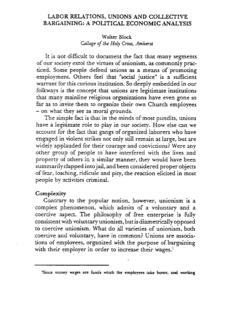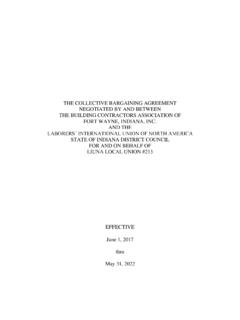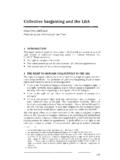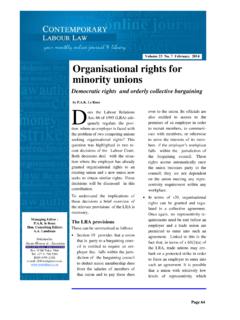Transcription of COLLECTIVE BARGAINING: LEVELS AND COVERAGE*
1 Chapter 5 COLLECTIVE bargaining : LEVELS AND COVERAGE* A. INTRODUCTION AND MAIN FINDINGS Industrial relations systems, operating at national, sectoral and local LEVELS , play an important role in deter- mining economic and labour market performance. They constitute a web of rules relating economic agents who, while pursuing their self-interests, generally find it beneficial to reach a degree of consent and some form of (more or less conflictual) co-operation. In providing pro- cedures for consensus-building and conflict resolution, these arrangcments are shaped by specific national legis- lation and labour market conditions, and by each country s prevailing attitudes towards work, conflict and co-operation.
2 There are many ways to analyse systems of labour relations in OECD countries. For example, Chapter 4 of the 1991 Employment Outlook examined trade union density (the proportion of workers who are union mem- bers), and noted widely differing rates of unionisation across countries, ranging from around 10 per cent in France to over 80 per cent in Sweden. Union density is just one indicator of the character of a country s industrial relations system. The extent to which employees are covered by collectivc agrccments concluded at various LEVELS - national, regional, sectoral or company - is another important feature of the system by which wages and other employment conditions are set.
3 In many countriec, workers who are not union mem- bers are in fact - through extension and enlargement provisions both within and outside the bargaining unit - covered by the terms and conditions of union contracts. In addition, strong unionisation in a sector or geographic area may induce non-union employers to offer terms and conditions similar to those found in COLLECTIVE agreements. Key features of COLLECTIVE bargaining arrangements are outlined in Section B. Irrespective of the level at which bargaining takes place, a central goal is to reach compromises and agree upon rules for facilitating conflict resolution. Importantly, collectivc ncgotiation over the terms of employment can also have the function of providing COLLECTIVE goods , the nature of which will depend on central features of the bargaining system.
4 For example, multi-employer bargaining can facilitate certain kinds of economic restructuring through provi- sions on training and skill formation, where both market and government failure are likely impediments [OECD (1993); Soskice (1990)l. It may also standardize employment conditions, taking wages out of competition. Nothing, however, guarantees that such COLLECTIVE goods will actually bc produced and, even if hey are, worker and employer organisations may not attach the same val- ues to them. Apart from discussing these factors, Sec- tion B introduces the various LEVELS at which bargaining can occur and the concept of co-ordination between LEVELS .]
5 Institutional, structural and economic factors which dctcrmine the spread and scope of COLLECTIVE bar- gaining are also outlined. Section C presents the available information on col- lective bargaining coverage (and unionisation rates) for OECD countries. Several findings are of particular importance. First, in 12 out of 17 countries for which data (referring generally to 1990) were available, at least two-thirds of e~nployccs are covered by COLLECTIVE agree- ments. Second, as is the case with rates of unionisation, coverage rates vary widely: the Nordic countries and mosl ol continental Europe have a much higher level of coverage than North America and Japan.
6 Third, while a high rate of unionisation leads, by definition, to a high coverage rate, the opposite is not necessarily the case. For example, the unionisation rate in France and Spain is roughly 10 per cent, yet COLLECTIVE bargaining coverage is 92 and 68 per cent, respectively. The empirical findings of large differences in cover- age across countries and of considerable variation between unionisation and coverage within countries is prima facie evidence of the importance of institutional factors. Section D, therefore, explores some of thcse in greater dctail, Three elemenls 01 COLLECTIVE bargaining * This chapter is based on a drilft by Dr. Franz Traxler from the University of Vicnna, using data received from private consultants and national statistical offices.
7 The chapter also uses a data set on trade union density supplied by Dr. Jelle Visser from the Univcrsity of Amsterdam. 167 .. that arc particularly important are examined: i) the pre- vailing level at which COLLECTIVE agreements are con- cluded; ii) the degree of co-ordination between LEVELS ; iii) the importance of extension mechanisms. Countries characterised by single-employer bargaining , such as Canada, Japan and the United States, tend to have lower coverage rates compared with countries where bargaining is conducted at higher LEVELS and where employer organisations and union federations are strong. Strong unions, however, are not necessary for high coverage rates.
8 For example, relatively high rates in Belgium, France and Portugal seem partly attributable to the importance of extension mechanisms in these countries. In light of the findings on bargaining LEVELS and extension mechanisms, there is some reason to believe that if the provision of COLLECTIVE goods is an impor- tant factor in attracting employers to COLLECTIVE bargain- ing, it is more likely the case for multi-employer bargain- ing. This is because industry-wide agreements tend to take wages and other working conditions out of competi- tion, and because the bargaining is more distant from the enterprise and therefore tends to place fewer restrictions on managerial prerogatives such as work assignments, Other economic and institutional determinants of covcragc rates, such as sectoral characteristics and firm size, are addressed in Section E.
9 While coverage varies across industries - with manuhcturing and transportation tending to show the highest coverage rates - the degree of cross-industry variation is rather dissimilar across countries: high in systems where single-employer bar- gaining is predominant and comparatively low in most countries characterised by multi-employer bargaining . Section F examines an important issue for policy- makers: has there been a trend in recent years towards decentralisation in COLLECTIVE bargaining , and in labour relations more generally? lf so, this should take the form of increased bargaining at the enterprise and/or establish- ment level, The empirical evidence, largcly qualitative, is mixed.
10 Some countries, such as the United Kingdom and New Zealand, have moved in this direction with a signiti- cant decline in multi-employer forms of bargaining . The evidence is less clear for most other countries, some of which have moved towards centralisation and decentral- isation simultaneously, depending on the issues involved. Section F also examines the hypothesis that the past decade has witnessed an important trend towards deregu- lation of labour relations and markets. The argument here is that, for a variety of reasons, individual employment relations are increasingly replacing COLLECTIVE agree- ments. The limited time-series data on coverage rates suggest a more nuanced view.

















